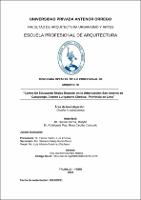| dc.contributor.advisor | Pesantes Aldana, Karen | |
| dc.contributor.author | Quispe Cerna, Maryliz | |
| dc.contributor.author | Rodríguez Paz, Rosa Cecilia Consuelo | |
| dc.creator | Quispe Cerna, Maryliz | |
| dc.date.accessioned | 2021-08-18T22:19:13Z | |
| dc.date.available | 2021-08-18T22:19:13Z | |
| dc.date.issued | 2021 | |
| dc.identifier.uri | https://hdl.handle.net/20.500.12759/7910 | |
| dc.description.abstract | El aspecto educativo en nuestro país es sin duda un punto álgido que con el
pasar de los años en vez de desarrollarse, involuciona, más aún si los usuarios
directos son niños con habilidades especiales que rara vez son considerados en
los planes de desarrollo del Ministerio de Educación. Aunado a ello tenemos la
problemática desde el punto de vista arquitectónico y el escaso estudio que
existe de propuestas correctas para el desarrollo de las actividades de dichos
niños, que como cabe mencionar necesitan ambientes amplios, funcionales y
bien organizados.
Por otro lado, la oferta es bastante más amplia que la demanda actual y
considerando el crecimiento en número con el transcurrir de los años de los niños
con habilidades especiales, es imperioso contar con centros que se encuentren
en correcto funcionamiento arquitectónico.
Por todo lo mencionado es que la presente tesis brinda un estudio a profundidad
de la programación arquitectónica correcta y funcional de un Centro Básico de
Educación Especial y la propuesta arquitectónica que cumple no solo con tal
programación, sino que se encuentra a la vanguardia en lo que al diseño
arquitectónico corresponde, con aulas correctamente equipadas,
dimensionamiento de mobiliarios, espacios recreativos, áreas verdes, talleres y
zonas de exposición. De tal forma se contribuye al desarrollo y estudio de nuevas
programaciones arquitectónicas y al desarrollo de propuestas que brinden
inclusión de niños con habilidades especiales. | es_PE |
| dc.description.abstract | The educational aspect in our country is undoubtedly a high point that over the
years, instead of developing, regresses, even more so if the direct users are
children with special abilities that are rarely considered in the development plans
of the Ministry of Education. Education. In addition to this, we have the problems
from the architectural point of view and the scarce study that exists of correct
proposals for the development of the activities of these children, which, as it
should be mentioned, need spacious, functional and well-organized
environments.
On the other hand, the offer is much broader than the current demand and
considering the growth in number over the years of children with special abilities,
it is imperative to have centers that are in correct architectural operation.
For all the aforementioned, this thesis provides an in-depth study of the correct
and functional architectural programming of a Basic Center for Special Education
and the architectural proposal that complies not only with such programming, but
is at the forefront in what corresponding to architectural design, with properly
equipped classrooms, sizing of furniture, recreational spaces, green areas,
workshops and exhibition areas. In this way, it contributes to the development
and study of new architectural programming and the development of proposals
that provide inclusion of children with special abilities. | en_US |
| dc.description.uri | Tesis | es_PE |
| dc.format | application/pdf | es_PE |
| dc.language.iso | spa | es_PE |
| dc.publisher | Universidad Privada Antenor Orrego | es_PE |
| dc.relation.ispartofseries | MEM_ARQ_616 | |
| dc.rights | info:eu-repo/semantics/openAccess | es_PE |
| dc.rights.uri | https://creativecommons.org/licenses/by/4.0/ | es_PE |
| dc.source | Universidad Privada Antenor Orrego | es_PE |
| dc.source | Repositorio Institucional - UPAO | es_PE |
| dc.subject | Centro | es_PE |
| dc.subject | Básico | es_PE |
| dc.title | Centro de educación básica especial en la urbanización san Antonio de carapongo, distrito Lurigancho Chosica - provincia de Lima | es_PE |
| dc.type | info:eu-repo/semantics/bachelorThesis | es_PE |
| thesis.degree.level | Título Profesional | es_PE |
| thesis.degree.grantor | Universidad Privada Antenor Orrego. Facultad de Arquitectura, Urbanismo y Artes | es_PE |
| thesis.degree.name | Arquitecto | es_PE |
| thesis.degree.discipline | Arquitectura | es_PE |
| dc.subject.ocde | https://purl.org/pe-repo/ocde/ford#6.04.08 | es_PE |
| renati.advisor.orcid | https://orcid.org/0000-0003-3750-1725 | es_PE |
| renati.author.dni | 42084351 | |
| renati.author.dni | 44941052 | |
| renati.advisor.dni | 40657712 | |
| renati.type | https://purl.org/pe-repo/renati/type#tesis | es_PE |
| renati.level | https://purl.org/pe-repo/renati/level#tituloProfesional | es_PE |
| renati.discipline | 731176 | es_PE |
| renati.juror | Tarma Carlos, Luis Enrique | |
| renati.juror | Rubio Pérez, Shareen Maely | |
| renati.juror | Gutiérrez Pacheco, Luis Alberto | |
| dc.publisher.country | PE | es_PE |


